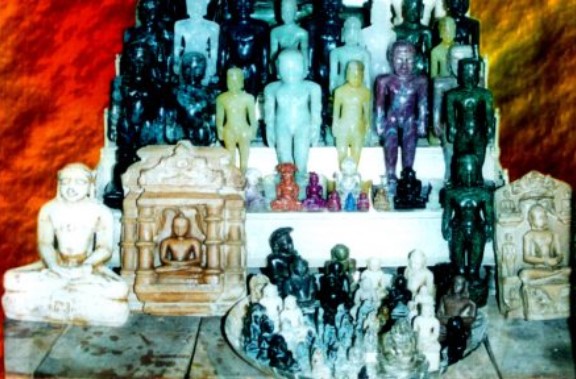Ṇamōkāra mantra is the most significant mantra in Jainism. This is the first prayer recited by the Jains while meditating. While reciting this mantra, the devotee bows with respect to the Panch Parameshti (the Supreme Five):
- Arihant— Those who have destroyed the four inimical karmas
- Siddha — The liberated souls
- Acharyas — The spiritual leaders or Preceptors
- Upadhayaya — Preceptor of less advanced ascetics
- Sādhu — The monks or sages in the world
ARIHANTAS
The word Arihanta is made up of two words: 1) Ari, meaning enemies, and 2)hanta, meaning destroyer of the enemies. These enemies
are inner desires known as passions such as anger, ego, deception, and greed within us. When a person (soul) wins over these
inner enemies he/she is called Arihanta. Arihanta destroys the four ghati karmas namely Jnanavarniya (knowledge blocking) Karma,
Darshanavarniya (perception blocking) Karma, Mohniya (passion causing) Karma and Antaraya (obstacle causing) Karma. Arihanta
attains: 1) Kevaljnan, perfect knowledge due to the destruction of all Jnanavarniya Karmas, 2) Kevaldarshan, perfect perception
due to the destruction of all Darshanavarniya karmas, 3) becomes passionless due to the destruction of all Mohniya Karmas, and 4)
gains infinite power due to the destruction of all Antaraya Karmas.
SIDDHAS
Siddhas are the liberated souls. They are no longer among us because they have completely ended the cycle of birth and death.
They have reached the ultimate highest state, salvation. They do not have any karmas, and they do not collect any new karmas.
This state of true freedom is called Moksha.
ACHARYAS
Acharyas carry the message of Jina. They are our spiritual leaders. Acharyas must have to do in-depth study and achieve mastery
of the Jain scriptures (Ägams). In addition to acquiring a high level of spiritual excellence, they have the ability to lead
the monks and nuns. They know various languages with a sound knowledge of other philosophies and religions of the area and the
world.
UPADHYAYAS
The title Upadhyayas is given to those Sadhus who have acquired a special knowledge of the Ägams and philosophical systems.
They teach Jain scriptures to sadhus and sadhvis.
SADHUS AND SADHVIS
When householders become detached from the worldly aspects of life and get the desire for spiritual uplift (and not worldly
uplift), they give up their worldly lives and become sadhus (monk) or sadhvis (nun). A male person is called sadhu, and a
female person is called sadhvi. At the time of Deeksha, the sadhu or sadhvi voluntarily accepts to obey following five major
vows for the rest of his/her life:
- Commitment of Total Ahimsa (non-violence)-not to commit any type of violence.
- Commitment of Total Satya (truth)-not to indulge in any type of lie or falsehood.
- Commitment of Total Asteya (non-stealing)-not to take anything unless it is given.
- Commitment of Total Brahmacharya (celibacy)-not to indulge in any sensual activities
- Commitment of Total Aparigraha (non-possessiveness)-not to acquire more than what is needed to maintain day to day life.

